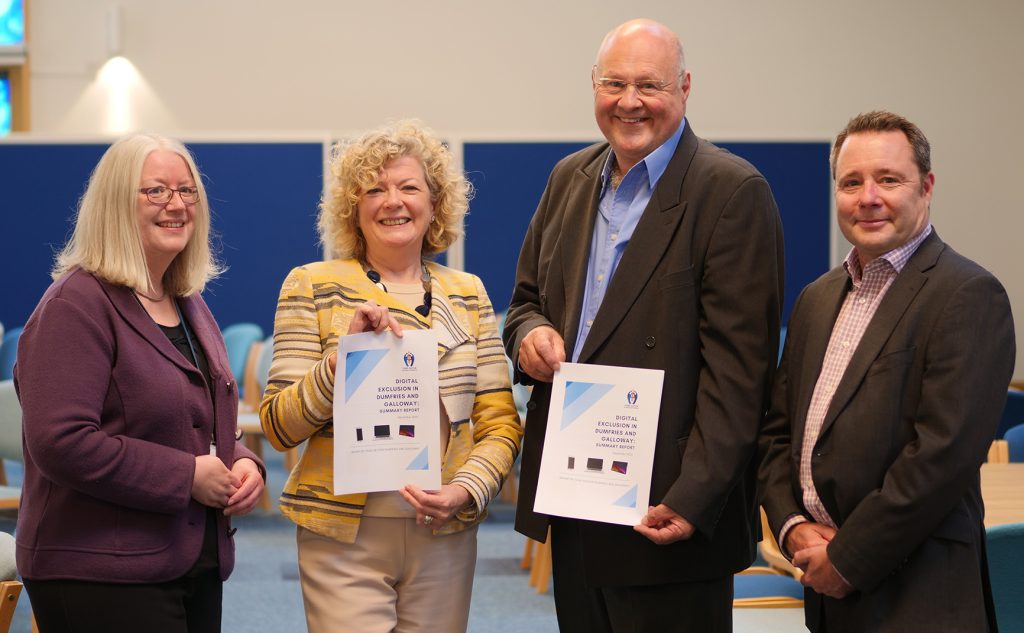Motivation and quality of access are now the two main barriers to digital exclusion across Dumfries and Galloway, a new research report launched this week has revealed.
Responses from just under 900 people across a wide socio-economic background to an in-depth questionnaire showed few now had no digital access at all.
Instead, a reluctance to use online services and issues like the speed and reliability of internet access are the main hurdles.
The research report from Third Sector Dumfries and Galloway (TSDG) was revealed at a special event on Tuesday in front of an audience with an interest in the subject, locally and nationally.
The report, with responses from every postcode area in the region, develops an in-depth understanding of digital exclusion, particularly focused on third sector service users, and follows on from an initial report two years ago.
Local organisations were remunerated to gather the research data from service users.
Discussions will now be held on the best way forward, with the report having wider implications for organisations, partnerships, and policy makers.
Norma Austin Hart, TSDG’s Chief Executive Officer, said: “We hope that this research will trigger partnership working across the public and third sectors to address this complex issue and make best use of our resources.
“It has never been more important to be able to participate in the digital world. So much of our lives is now conducted online. This research gives us in-depth insight for the first time into the nature of digital exclusion in this large rural area.”
The report showed that motivation was now the main barrier to overcome digital exclusion. There are many people who know how to use online services but don’t want to and many who have no intention of learning.
There are still strong preferences for face-to-face services and getting friends and family to undertake transactions.
“Changing these will be challenging, as they are highly valued”, the report states.
But, while few respondents had no digital access, the quality of that access was very important. This could be the speed and reliability of internet signal or the quality, age, and number of devices – for example one older smartphone may be shared by multiple members of a low-income family.
The report states: “The issue of cost was the main issue raised in the lower income groups, followed by device. This fits with other research data suggesting lower income groups have fewer devices in a household and commonly use their mobile as the main device or an out-of-date laptop or tablet.”
The report also shows that a lack of confidence to use online services was still a big consideration, as well as support available to those who hit a technical block.
“Due to motivational issues, there is also a challenge in convincing people that there are benefits to them in learning to use the internet,” the report adds. These benefits could help an individual’s economic or health and wellbeing outlook.
The report also considers those who remain digitally excluded through choice, with a belief that there is no requirement for online access and no desire to change. It warns policy makers must consider this group, with many over 80 years old, if considering removing offline services.
“There is a need for health care, housing, and council services to remain accessible to them and not to move solely to online platforms,” the report states. “In the longer term more of the older generation will have used computers in their workplace and education and this will eventually become less of an issue. However, we cannot assume in the current economic situation that affordability may not become a much bigger issue.”
The research project was supported by partners, including the Institute for Research and Innovation in Social Services (Iriss), South of Scotland Enterprise, and Dumfries and Galloway Council.
Stuart Muirhead, Head of Delivery at Iriss, said: “This has been a crucial piece of research that should be able to meaningfully inform service provision and support for people across Dumfries and Galloway. It is not often we see an organisation identify an issue like digital exclusion and commit money and effort to really trying to understand what is going on and doing that in a way that involves so many local communities and organisations.”
The full and summary versions of the report can be accessed at the links below:
Report – Digital Exclusion in Dumfries and Galloway, September 2022
Summary Report – Digital Exclusion in Dumfries and Galloway, September 2022






